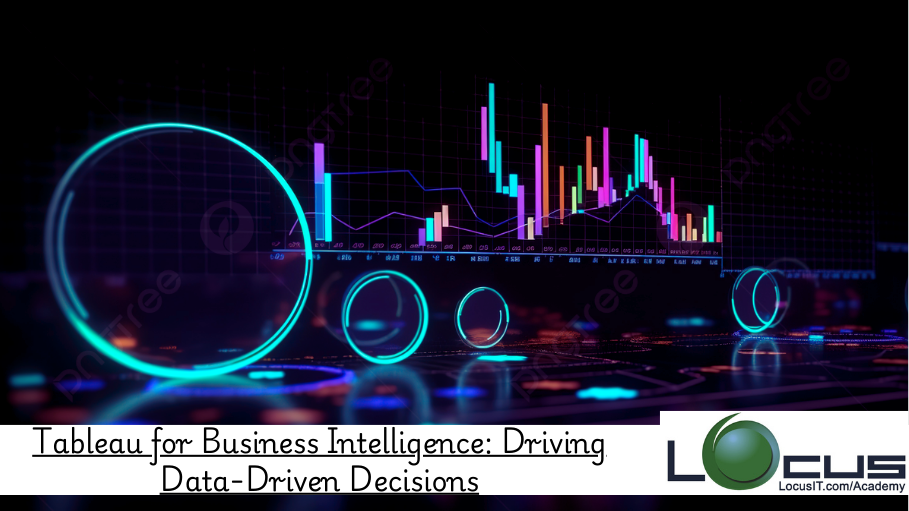Description
Introduction of Tableau for BI:
In the modern business landscape, data-driven decision-making is crucial for staying competitive and agile. “Tableau for Business Intelligence: Driving Data-Driven Decisions” is a comprehensive training course designed to equip business professionals with the skills to leverage Tableau for business intelligence (BI). This course focuses on using Tableau to transform raw data into actionable insights, enabling you to make informed decisions that drive business success. Through hands-on exercises, you’ll learn how to build powerful BI dashboards, perform in-depth data analysis, and communicate insights effectively to stakeholders.
Prerequisites:
- Basic understanding of data concepts (measures, dimensions, aggregations)
- Familiarity with Tableau (connecting to data sources, creating basic visualizations)
- Experience with business analysis or reporting is beneficial
Table of Contents:
Here’s the content organized in the correct order with headings and subheadings:
1: Introduction to Business Intelligence and Tableau
1.1 Understanding Business Intelligence (BI)
– What is BI and why it matters for organizations
– The role of data in driving business decisions
– Overview of BI tools and the unique strengths of Tableau
1.2 Tableau for BI
– Introduction to Tableau as a BI tool
– Overview of Tableau’s interface and key features for BI
– Connecting to various data sources (databases, cloud services, spreadsheets)
1.3 Setting Up Your BI Environment
– Best practices for organizing your Tableau workspace
– Importing and exploring business datasets
– Overview of the Tableau BI workflow
2: Building Core BI Visualizations
2.1 Designing BI-Focused Visualizations
– Identifying key metrics and KPIs for your business
– Choosing the right chart types for BI analysis
– Creating bar charts, line charts, and scatter plots for business insights
2.2 Visualizing Trends and Patterns
– Using trend lines and forecasting in Tableau
– Analyzing time series data for business trends
– Creating moving averages and rolling metrics
2.3 Advanced BI Visualizations
– Building heat maps, tree maps, and waterfall charts
– Using Gantt charts for project management BI
– Incorporating geographical data with map visualizations
3: Data Blending and Advanced Analysis
3.1 Data Blending Techniques
– Combining data from multiple sources for comprehensive BI analysis
– Performing data joins, unions, and blends in Tableau
– Managing complex relationships between datasets
3.2 Advanced Analytical Techniques
– Using calculated fields for custom metrics and KPIs
– Applying table calculations for advanced analysis
– Analyzing cohorts, segments, and trends
3.3 Scenario Analysis and What-If Modeling
– Creating scenarios and simulations in Tableau
– Using parameters for dynamic what-if analysis
– Visualizing the impact of different business strategies
4: Building Interactive BI Dashboards
4.1 Principles of Effective BI Dashboard Design
– Designing dashboards that provide clear and actionable insights
– Balancing detail and simplicity in dashboard design
– Using layout and design principles for effective BI dashboards
4.2 Creating Dynamic and Interactive Dashboards
– Adding filters, parameters, and interactive elements
– Building drill-down and drill-through capabilities
– Designing dashboards for different user roles (executives, analysts, etc.)
4.3 Optimizing Dashboards for Performance
– Techniques for improving dashboard load times
– Managing large datasets in dashboards
– Troubleshooting common performance issues
5: Communicating Insights and Making Data-Driven Decisions
5.1 Storytelling with BI Dashboards
– Crafting a narrative around your business data
– Using Tableau’s Story Points to create data-driven presentations
– Best practices for presenting BI dashboards to stakeholders
5.2 Collaborative Decision-Making with Tableau
– Sharing dashboards and collaborating with teams
– Using Tableau Server and Tableau Online for BI collaboration
– Gathering feedback and iterating on dashboards
5.3 Driving Decisions with Data
– Techniques for translating data insights into business action
– Case studies of data-driven decision-making in business
– Aligning BI insights with business strategy
6: Publishing and Sharing BI Dashboards
6.1 Publishing to Tableau Server and Online
– Steps for publishing dashboards for organization-wide access
– Managing permissions and user roles in Tableau Server
– Scheduling and automating BI report distribution
6.2 Embedding BI Dashboards
– Embedding dashboards in business applications and websites
– Using Tableau’s API for custom BI solutions
– Integrating Tableau dashboards with other BI tools
6.3 Monitoring and Maintaining BI Dashboards
– Best practices for maintaining up-to-date BI dashboards
– Monitoring dashboard usage and performance
– Continuous improvement of BI dashboards based on feedback
7: Capstone Project and Review
7.1 Capstone Project Overview
– Project guidelines and expectations
– Selecting a business problem and dataset for analysis
– Designing and building a comprehensive BI dashboard
7.2 Project Work and Presentations
– Working on individual capstone projects
– Peer review and group feedback sessions
– Final project presentations
7.3 Final Review and Next Steps
– Summary of key concepts and techniques
– Exploring additional resources and advanced BI topics
– Course conclusion and participant feedback
This course is designed to equip you with the knowledge and skills to harness Tableau for business intelligence, transforming data into actionable insights that can drive strategic decision-making in your organization. The capstone project will give you hands-on experience in applying these techniques, ensuring you are prepared to use Tableau effectively in your BI initiatives.
If you are looking for customized info, Please contact us here







Reviews
There are no reviews yet.